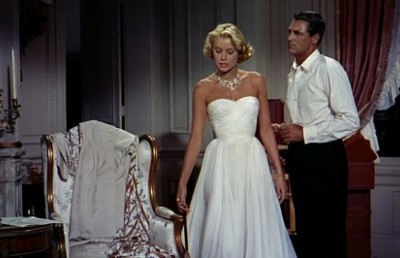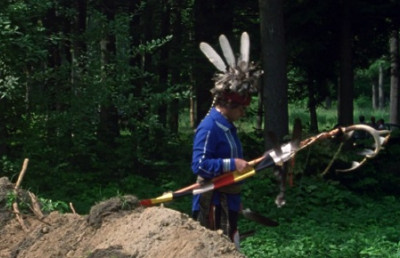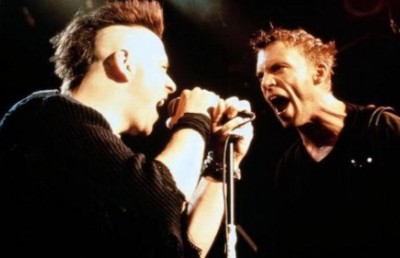Bruce McDonald and Don McKellar’s Deconstruction of Canadian Realism: Roadkill and Highway 61
Being Canadian, or Not Being American
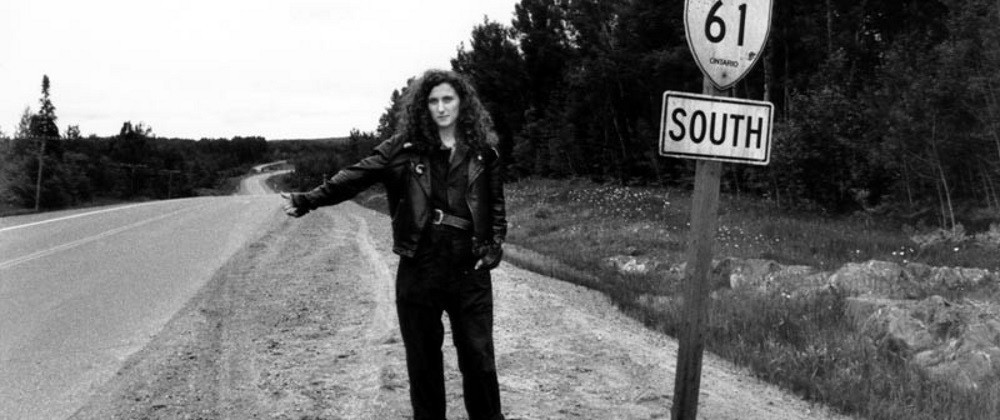
In their early career collaborations Roadkill (1989) and Highway 61 (1991), director Bruce McDonald and screenwriter-actor Don McKellar play with, and gently mock, the conventions of “classic” Canadian realist films of the 1960s and ‘70s, particularly the downbeat road movie Goin’ Down the Road (1970, Donald Shebib). In Roadkill, they use the satiric strategy of reversal, confounding audience expectations by inverting elements found in these pessimistic dramas, and replacing them with their exact opposites, while in Highway 61, they use parody, where the expected tropes are present, but in an absurdly exaggerated form, to challenge the version of Canada they present, notably the “loser hero” archetype. Roadkill also features a satirical take on Canadian feelings of inferiority towards the United States, and this is the central subject of Highway 61, where American culture and society, and even more importantly, Canadian perceptions of them, are both critiqued and celebrated. Beyond the road movie structure, what is common to both these films is that their lead characters do not suffer the humiliation and defeat that is the usual fate of protagonists in so many Canadian movies. Instead, it is by asserting their all too Canadian nerdiness that they become empowered and emerge as the heroes of their stories instead of the victims.
In order to understand McDonald and McKellar’s intentions, it is important to situate the making of these films within the period’s Canadian pop culture. As Paul McEwan writes, it is “impossible to consider” films like Roadkill or Highway 61 without placing them in the context of Canadian satire. Popular television shows such as SCTV (1976-84), Kids in the Hall (1988-95) and Codco (1987-92) were more or less contemporaneous, and all often featured both wry, self-deprecating takes on Canadian identity and an irony-drenched obsession with American TV, movies and music. 1 Even if neither McDonald nor McKellar had seen SCTV’s brutal parody of Goin’ Down the Road or Strange Brew (1983, Rick Moranis and Dave Thomas), the SCTV spinoff that featured lovable buffoons Bob and Doug Mackenzie, more or less parodic versions of Goin’ Down the Road’s Pete and Joey, 2 although it would not be too surprising if they had, the use of humour to critically examine cultural totems was clearly something that was in the air. And any film that is commemorated on a postage stamp, as Goin’ Down the Road is, can be considered a cultural totem.
Goin’ Down the Road is often considered the archetype of the “authentic” Canadian movie. 3 In Survival, Margaret Atwood points to it and The Rowdyman (1972, Peter Carter) as “dramatizations of failure” whose protagonists are “born losers” who embody the themes she considers central to Canadian literature. These films are, she writes, “pure Canadian, from sea to sea.” 4 Christine Ramsay writes that Goin’ Down the Road possesses the “exemplification of what are seen as the typical aesthetic markers of a film’s traditional ‘Canadianness’ (ie, stark, if not ‘depressing’ social realism; documentary flavor; eccentric and offbeat characterizations; contemplative treatment of the landscape).” 5 As Goin’ Down the Road can be seen, therefore, as not only a typical Canadian film, but as one widely regarded as the exemplar of the type, it is interesting to note the ways in which Roadkill turns it upside down.
The differences between the two films are generally not just variations, but a series of examples where specific elements of Goin’ Down the Road have been replaced with their exact opposites. For example, where Goin’ Down the Road centered on two working class men, Roadkill features a single middle class woman. From The Rowdyman to Nobody Waved Goodbye (1964, Don Owen) to Paperback Hero (1973, Peter Pearson) and on to many others, Canadian films tend to deal with men and, more precisely, their failures. This tendency was at one time so pronounced that Robert Fothergill wrote that “the version of la condition canadienne reflected to us by our feature films . . . is the depiction . . . of the radical inadequacy of the male protagonist.” 6 While Goin’ Down the Road and the other films mentioned can be seen as narratives of ebullient men being beaten down by fate or social forces or their own fecklessness, Roadkill traces the story of a put upon female who becomes empowered by her experiences on the road. As McKellar notes laconically, he deliberately helped make “kind of a feminist film,” 7 which is not how most would describe the realist dramas it references.
In a similar reversal, Goin’ Down the Road begins in a depressing small town landscape filmed in deliberately dreary colour and littered with burnt out cars, sunken or abandoned boats and makeshift cottages, and features a night on the town on Toronto’s Yonge St. as one of the few high spots of its protagonists’ stay in the big city. Roadkill, on the other hand, begins on Yonge St., which is not shown in this film as a fun hot spot, but a place of suffering where Jesus is being flogged in a reenactment of the Easter Passion, and then moves from a drab and grey Toronto to a dark and increasingly mysterious countryside shot in glossy black and white. This very atypical way of distinguishing visually between Toronto and its rural hinterland was deliberate, with McKellar stating that “part of the joke was to glamourize” northern Ontario. 8 In the sequence that follows, Ramona (Valerie Buhagiar), the film’s protagonist, is picked up at a gas station where the streetlights stand out as spots of brilliant white against a pitch black sky, making the landscape enigmatic and alluring. Later, there is a bizarre teen dance at an abandoned drive-in (illumination provided by the headlights of cars parked in a circle, as the kids dance to the Cowboy Junkies), and when Ramona finds out the age of her new friend (and the others at the dance), she asks “Fifteen? When do you start having sex around here?” The nonchalant reply that it would be difficult to imagine coming from Goin’ Down the Road’s Pete or Joey is “10:30, 11 o’clock, same as anywhere else.” All of which helps make small town Ontario seem infinitely hipper than the big city. As both Atwood and Fothergill consider Canadian stories of failures to be symptoms of Canada’s colonial relationship with the United States, 9 with, in the case of Goin’ Down the Road, Nova Scotia standing in for Canada and the mythical promised land of Toronto that they set out for standing in for the U.S.,Roadkill’s challenge to the traditional representation of small town Canada can also be seen as a challenge to this colonized mentality.
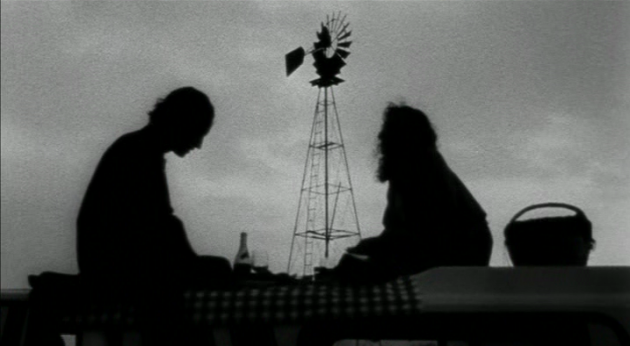
Roadkill
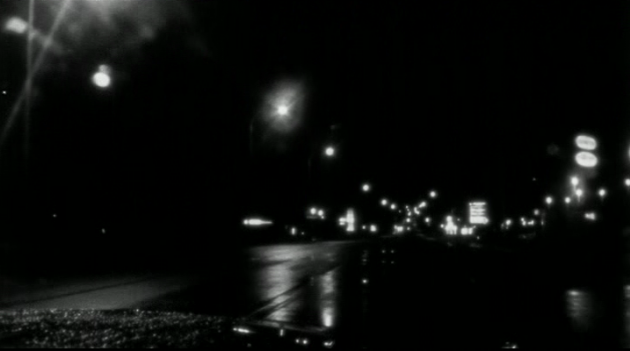
Roadkill: “Ontario’s mysterious rural landscape”
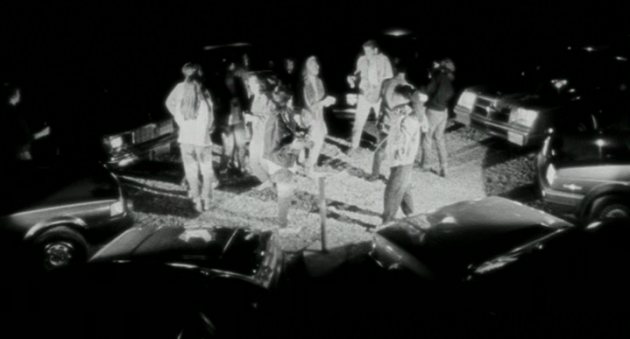
Roadkill: “The kids get down to the Cowboy Junkies”
Other reversals of Goin’ Down the Road found in Roadkill include that while Pete dreams of a job in the media, Ramona has a job in the media that, at least in the beginning of the film, is hardly the stuff of dreams. When Pete and Joey steal from a store, they are beaten, and a panicky act of violence sets the police after them. When Ramona steals from a store, it’s a cheerful lark that results in her obtaining a new, sexy wardrobe. While both films, like most road movies, feature extensive use of landscape shots, Roadkill’s less than reverent approach to this genre staple is exemplified by a scene where characters spray paint graffiti on Sudbury’s Big Nickel 10 and, most famously, cook a roadkill meal on a car radiator. McDonald and McKellar appreciate the Canadian landscape so much, they have one of the film’s characters (played by McKellar himself) eat some of it! It is unlikely that anybody will describe this sort of treatment of the landscape as “contemplative.”
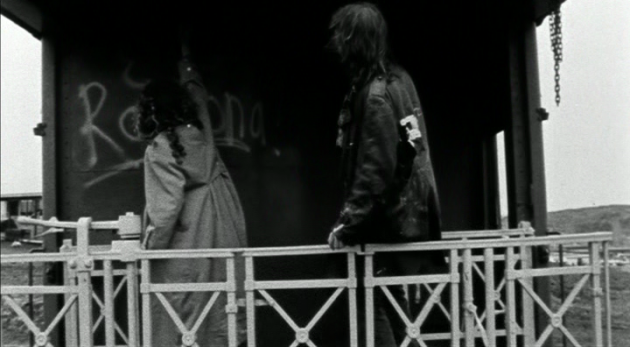
Roadkill: “Ramona (Valerie Buhagiar) and director Bruce Shack (Bruce McDonald) encounter Sudbury’s Big Nickel”
Roadkill’s most important reversal is that it is not a narrative that recounts a string of setbacks and defeats, but instead details a series of encounters where an increasingly confident Ramona is helped on her way by the kindness of strangers. If Goin’ Down the Road was a reworking of The Grapes of Wrath (1940, John Ford), but with an even more pessimistic ending, the classic Hollywood road film McKellar claims to have had in mind when writing Roadkill’s script was The Wizard of Oz (1939, Victor Fleming). 11 Ramona’s voyage is, like Dorothy’s, one of self-discovery that is punctuated by a series of encounters with new friends who help her on her way. Ramona’s gradual empowerment can be seen in her learning to drive during the course of the film. At the start, her mean boss calls her “useless” because she can’t drive, but several of the strangers she meets give her driving tips. The taxi driver who takes her north explains why driving is easy (“all you need is a tape deck and a good supply of dope”); the film director, played by Roadkill director Bruce McDonald, consoles her after she runs over a muskrat on her first attempt at driving (“If you want to drive, you have to kill”); Russell the aspiring serial killer offers practical advice (“You can look at the rear view mirror every now and then if you like”) and Luke, the teenage boy (Mark Tarantino) loans her his car. By the end of the film, Ramona is a good enough driver to avoid running over a bunny in the middle of the road and adding to the film’s high roadkill count. The fact that the advice Ramona receives borders on the nonsensical is very much part of the film’s departure from realism in favour of heavy doses of irony.
Also, instead of finishing with a situation where the lead character is left frustrated and defeated, McKellar argues that the climactic rock concert sequence shows various characters receiving something they wished for, as in The Wizard of Oz. Russell gets the attention he craves by finally killing somebody; Matthew, the confused rock star, goes “all the way” by dying onstage; the director gets great footage for his documentary; the teenaged boy gets a guitar; and Ramona picks up the fallen microphone and stands center stage, finally becoming the star of her own film. 12 While this is true to some extent, it does not quite incorporate the film’s ironic stance towards most of its characters. For while many of these characters indeed have a wish granted, there is usually a catch. Russell’s killing of a single person is upstaged by Ramona’s boss emerging as a genuine mass murderer; Matthew gets to die onstage, but is hardly in a position to enjoy the experience; the director has dynamite footage for a documentary he will never finish, and the teenager gets a guitar, but is wounded in the process. Ironically, it is only Ramona, the would be “loser protagonist,” who emerges something of a winner.
The question remains of what to make of the climactic massacre of many of Roadkill’s characters, though not Ramona. For once in this film, the filmmakers do not pull a reversal, but retain a characteristic element of Canadian cinema and push it to the extreme. Atwood writes that Canadian stories “are likely to be tales not of those who made it but those who made it back from the awful experience . . . that killed everybody else,” 13 while the film’s producer, Colin Brunton, notes more prosaically: “There’s a thing in Canadian films where people die in the end a lot.” 14 But Ramona is not just an archetypal Atwoodian survivor, she is a winner who triumphs largely because she is nice to the people she meets and they are, in return, nice to her as she learns to stick up for herself. A measure of the layers of irony that McDonald and McKellar bake into the film’s narrative is that for all they do to make the idea of Canadian niceness a running joke, they still end up with Ramona ending up smarter and more self-confident as a result of the very Canadian qualities they spend the film poking fun at.
An example of this mockery of Canadian niceness is on view in the character of Russell, whose dream is to become a serial killer, even though he has never actually killed anybody. McKellar wrote this part for himself, and perhaps not too coincidentally gave himself most of the film’s funniest lines. The role has an element of self-parody in it because, as McKellar notes about his own career as a filmmaker, “at the time, California is where you went if you wanted to make films or be a serial killer.” 15 This speech is what he wryly describes as the film’s “Canadian statement.” 16 In it, Russell rails against the “colonial mentality” that serial killers have to be American and insists he is going to change this. This so-called nationalist conceit, which David L. Pike describes as “an attitude of distanced but passionate appropriation” of the “American tradition of the serial killer to rural Ontario” 17 is reinforced by a series of references to Hollywood films on the topic, notably Psycho (1960, Alfred Hitchcock), and including a beautiful visual quote from Badlands (1973, Terrence Malick), when Russell and Ramona are eating their roadkill dinner on the roof of his car with a windmill in the background.
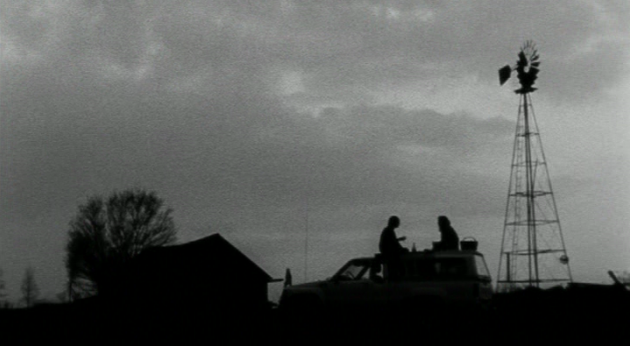
Roadkill: “Ramona and Russell enjoy a moonlight dinner of roadkill”
The film’s poking fun at Russell’s mixture of fascination for American culture and frustration at his presumed inability to take part in it without travelling to the U.S. point to another important context for the McDonald-McKellar collaborations. From the mid-1980s through to the mid-1990s, a number of Ontario-produced movies were loosely grouped together by some critics as the “Toronto New Wave.” 18 These were low budget films, set in or around Toronto, that tended to feature quirky characters and understated irony. Instead of the documentary-influenced social realism of films like Goin’ Down the Road, they aimed for an art film aesthetic. Or as Cameron Bailey put it, they “didn’t just oppose phony American-style genre movies with flag-waving Canadian grit . . . they opposed commercial cinema with personal cinema.” 19 Instead of a self-consciously nationalist point of view, these filmmakers often saw themselves as part of a counter culture that cut across national borders. 20 Part of this reaction against the archetypal Canadian realist cinema was a rejection of the resentment towards the dominance of American culture implied in the earlier dramas that allegorized Canada’s cultural colonization. Roadkill is aware of the colonized relationship, but treats it ironically, acknowledging not only the fact of colonization, but also the very real attraction of American culture and the way in which it permeates Canadian culture.
This complicated relationship with American culture is even more central to Highway 61, a film that finds barber and would be trumpet player Pokey Jones (McKellar, who again wrote the script) and ex-roadie “on the run from a heavy metal band” Jackie (Buhagiar) on a journey, as Pike puts it, “from Thunder Bay through the heartland of American clichés to New Orleans.” 21 Pike’s use of the word cliché here is well chosen, because the satiric strategy here is not the series of reversals used in Roadkill, but a knowing parody of all too familiar genre tropes.
The alternative to Canadian films with hapless heroes who go down the road in the vain hope of finding something better are often films like The Rowdyman, where hapless heroes fume about being stuck in their hick towns, but lack the will to leave. In Highway 61, Pokey dreams about going to the U.S., but not only is he too paralyzed to leave his small town home (so small that Thunder Bay is referred to as the “big city”), he has a car he has never even driven out of his garage. However, in this film, his “loser’ characteristics may not necessarily be negative attributes. Christine Ramsay writes that “in Pokey Jones as the perennial Canadian male ‘loser’ (ie, the guy who can’t play the trumpet, whose car is his best friend, who is reluctant to shoot a chicken) there are clearly human qualities (such as well meaning generosity and subdued competence) to be desired, celebrated and admired.” 22 The sequence involving the chicken hunt is a good example of what might be described as meek heroism. Pokey’s refusal to blast away at the cornered chicken (unlike his psychotic rock star hosts who have achieved the American Dream of wealth and fame) is admirable, and is recognized as such even by the more Americanized Jackie. Therefore, Paul McEwan’s observation that Pokey is “a stereotype of the emasculated Canadian male” who “can’t play his trumpet, is meek mannered, and takes almost no decisive action throughout the film” 23 is not quite accurate, although the film certainly trades on the expectation that viewers will be very familiar with that stereotype. Instead, the film can be seen, like Roadkill, as a narrative of empowerment, where Pokey begins as a passive figure, but becomes increasingly assertive as the film progresses. At the beginning of the film, Pokey is coerced, not unwillingly, by Jackie to drive her and the coffin south; she has to point a gun at him to get him to have sex with her, although again, not unwillingly; and he stands by silently as Jackie finances their trip through shoplifting. However, his own character emerges in the face of Jackie’s thoughtless “American” ways. He refuses to kill the chicken, raises money by opening a sidewalk barber shop, and tracks down the stolen corpse. In the end, it is his disapproval of Jackie’s intended drug deal that converts her. The finale is a triumph of Canadian nerdiness over American cool.
Pokey’s growing assertiveness is tied to his growing disillusion with the United States. The arc of the film is surprisingly similar to that of a film made a few years before it, although in most other ways very dissimilar, Sandy Wilson’s My American Cousin (1985). That film begins famously in a small town where, as the young heroine writes in large block letters in her diary, “NOTHING EVER HAPPENS.” The arrival of her handsome American cousin who drives a flashy car, chases girls, and listens to rock ‘n’ roll dazzles her; but by the end of the film she learns to be less starry eyed. Similarly, Pokey’s initial obsession with American culture is followed by gradual disillusionment. If Roadkill lifts its template from The Wizard of Oz, then Highway 61 borrows from another classic American road movie, Easy Rider (1969, Dennis Hopper). Both are journeys by an odd couple from the margins into the heart of America that begin with a drug deal, involve encounters with people who illustrate various aspects of contemporary American malaise, and include memorable stops in New Orleans. But where Wyatt and Billy find death in the heartland and become martyrs to the country that might have been, Pokey triumphs by rejecting exaggerated versions of the dark side of America and instead reaffirming his Canadianness.
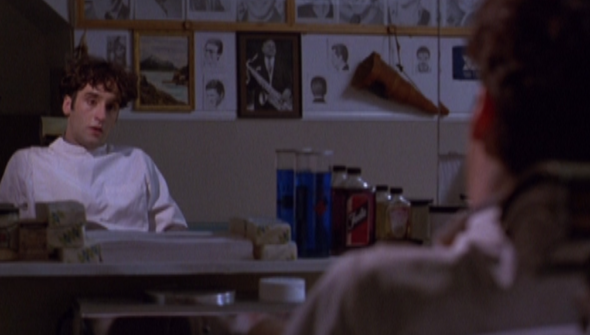
Highway 61: “Pokey (McKellar) in his barbershop, the walls lined with images of his (American) cultural idols”
The role of exaggeration is very important. In Highway 61, the contrast between Canada and the United States is deliberately magnified and distorted. As McEwan notes: “The shots of Canada at the beginning of the film emphasize the pastoral . . . As they begin their trip down the Canadian section of Highway 61, the background is without development, beautiful and unspoiled.” 24 On the American side, however, “all the landscape shots include some sort of constructed interruption, like power lines or a scrap yard.” 25 Although there is no shortage of rusting industrial landscapes in Ontario or unspoiled wilderness in northern Minnesota, the stereotyped images signal that the film is less about the differences between Canada and the United States than it is about popular Canadian perceptions of those differences. The use of this kind of contrasting representations comments on how Canadians often define their identity through real or imagined distinctions between themselves and their American neighbours. 26 As Canadian filmmaker Lynne Stopkewich puts it, Canadians are “constantly defining ourselves through difference. Our culture is owned by Americans. You’re always looking in, always pushing your face up against the glass . . . [and] it gives you a distance from which you can be critical, not just of the other but of yourself at the same time.” 27 Or, as McEwan writes: “The question of Canadian distinctiveness always hinges on differences from Americans, because of the immense similarities between the two nations.” 28 What marks Roadkill and Highway 61, along with some other “Toronto New Wave” films, and TV comedy shows of the period such as SCTV, was a willingness to acknowledge and ironically examine the complex mixture of attraction and repulsion American culture holds for Canadians, and the central place this relationship holds in the Canadian imagination.
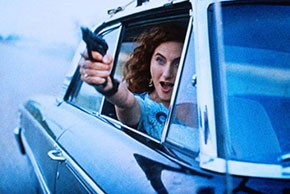
Highway 61:“Jackie (Buhagiar) enjoying the freedom of being American”
Roadkill and Highway 61 express a nuanced approach to American culture. Although they are critical of its excesses, they also reveal a deep knowledge and appreciation that is also characteristic of many Canadians. As André Loiselle writes, “Pokey’s devotion to American popular music, his in-depth knowledge of a highway he has never travelled, foregrounds the ironic condition of a section of Canadian culture that is entrenched in Americana.” 29 These are characteristics Pokey clearly shares with filmmakers McDonald and McKellar. When Pokey and Jackie cross the border into the U.S., the American flag is framed for several seconds as The Ramones are heard on the soundtrack, blasting away at the nostalgic “Do You Remember Rock ‘n’ Roll Radio?” In a Bruce McDonald film, there is no greater signifier of affirmation than being associated with a Ramones song, and while it is used in part to illustrate Pokey’s high expectations and in part to comment ironically on the ugly landscape they are driving through, it cannot help also being a celebration of all that is admirable about American culture. This love for and fascination with America is further shown in a soundtrack that features the various types of music associated with the legendary highway they are travelling down, including rock, blues, gospel, jazz and Cajun, and includes visits to such iconic locations as the boyhood home of Bob Dylan.
The scene at the childhood home of Dylan (between the ages of 1 and 6) is characteristic. As Pokey rhapsodizes about standing on the driveway where the young bard might have pedaled his tricycle, Jackie stares bemusedly at a singularly unimpressive house. Like the earlier pairing of the Ramones song with ugly landscape shots, this both celebrates American culture and comments on the gap between American myth and American reality, along with the detailed knowledge Canadians possess about it. Similarly, in an earlier scene where Pokey is playing his trumpet (very badly) under the stars, he is approached by Satan, who says he can make him a great trumpet player, echoing the legends concerning Robert Johnson and other blues musicians who are said to have sold their souls at the crossroads in exchange for musical genius. Except that this Satan is a nutjob who lives in a modest house in a suburb of Baton Rouge. Pokey will soon meet a family maniacally chasing the American Dream through a show business success which has no chance of happening and, later, a couple who have achieved rock stardom and been driven insane by it. While still dazzled by his American experience, Pokey had enjoyed shooting at highway signs, but the disillusion that develops as a result of this series of bizarre encounters solidifies when he refuses to shoot the chicken. Shooting animals point blank seems, in this context, somehow un-Canadian. His ability to act on this perceived cultural difference, unthinkable when he was back in small town Ontario, suggests that, like Roadkill, this is a journey of self-discovery and empowerment.
This is most clearly shown when Pokey tries to raise money to continue his trip after his car is destroyed. He first tries to play his trumpet on the street, but then comes to his senses and takes out his barber tools. It is a recognition that he cannot succeed by copying Americans badly, but by being true to his nerdy Canadian self. Jackie disparagingly tells him: “You’re not a musician, you’re a barber. A Canadian.” Yet in this scene, Pokey turns a theoretical negative into a positive. Therefore, when McEwan writes that Pokey “becomes disillusioned with Jackie and America to some extent . . . he never gains the maturity that would make him into an active heroic protagonist,” 30 he may be missing something. It is certainly true that Pokey is not a hero in the classic Hollywood sense (he tracks down Satan, but Jackie has to rescue him), but he succeeds in transporting the corpse to New Orleans and, because of his objections, the drug deal is stopped. And he gets the girl.
By converting the Americanized Jackie to his nerdy Canadian convictions, Pokey becomes the hero of his film thanks to the Canadian flaws that would normally mark him as a “loser.” McEwan comments that Highway 61 “succeeds as a commentary on Canadian national identity, but offers no direct answer to the question of what Canadianness might be.” 31 This statement is open to challenge. Of course, Pokey is an exaggerated parody of the archetypal Canadian loser, and the filmmakers are clearly aware of the ironies involved in framing Pokey’s empowerment in a wildly unrealistic fantasy. However, by making him the triumphant hero of this fable, McDonald and McKellar are suggesting that while Canada may indeed have a colonized culture and may be America’s weaker brother as described by Robert Fothergill, this still does not mean Canadians have to be victims. As long as they remain aware of who they are, nerds can win too.
BibliographyAtwood, Margaret. Survival. Toronto, ON: House of Anansi Press Ltd., 1972
Bailey, Cameron. “Standing in the Kitchen All Night: A Secret History of the Toronto New Wave.” Take One. 28 (2000). http://www.stevesanguedolce.com/Reviews/TAKE%20ONE.htm
Brunton, Colin, and Don McKellar. “Audio Commentary.” Roadkill. DVD. Directed by Bruce McDonald. Toronto, ON. Video Service Corp., 2004.
Fothergill, Robert. “Coward, Bully or Clown: The Dream-Life of a Younger Brother.” Take One. 4.3 (1973), 234-250.
Harcourt, Peter. “Introduction.” Canadian Film Reader. Eds. Seth Feldman, Joyce Nelson. Toronto, ON: Peter Martin, 1977
Loiselle, André. “The Radically Moderate Canadian: Don McKellar’s Cinematic Persona.” North of Everything: English Canadian Cinema Since 1980. Eds. William Beard and Jerry White. Edmonton, AB: University of Alberta Press, 2002, 256-269.
McEwan, Paul. “Satire as Magnifying Glass: Crossing the U.S. Border in Bruce McDonald’s Highway 61.” Symploke 15.1-2 (2007): 115-124.
Morris, Peter. “In Our Own Eyes: The Canonizing of Canadian Film.” Canadian Journal of Film Studies. 3.1 (1994), 27-44.
Pevere, Geoff. Donald Shebib’s Goin’ Down the Road. Toronto, ON: University of Toronto Press, 2012.
Pike, David L. “Across the Great Divide: Canadian Popular Cinema in the 21st Century.” Bright Lights Film Journal. 56 (2007). http://brightlightsfilm.com/across-great-divide-canadian-popular-cinema-21st-century/#.WRSmwNy1vxk
Ramsay, Christine. “Canadian Narrative Cinema from the Margins: ‘the Nation’ and Masculinity in Goin’ Down the Road.” Canada’s Best Features: Critical Essays on 15 Canadian Films. Ed. Eugene P. Walz. New York, NY: Rodopi, 2002, 3-26.
White, Jerry. “35-mm Non-Fiction: An Interview with Ron Mann.” North of Everything: English Canadian Cinema Since 1980. Eds. William Beard and Jerry White. Edmonton, AB: University of Alberta Press, 2002, 222-231.
Notes
- Paul McEwan, “Satire as Magnifying Glass: Crossing the U.S. Border in Bruce McDonald’s Highway 61.” Symploke 15.1-2 (2007): 120. ↩
- Geoff Pevere, Donald Shebib’s Goin’ Down the Road. Toronto, ON: University of Toronto Press, 2012, 20. The resemblance has been remarked on by no less than Donald Shebib, director of Goin’ Down the Road. ↩
- Peter Morris, “In Our Own Eyes: The Canonizing of Canadian Film.” Canadian Journal of Film Studies. 3.1 (1994), 30; Peter Harcourt, “Introduction.” Canadian Film Reader. Eds. Seth Feldman, Joyce Nelson. Toronto, ON: Peter Martin, 1977, 370. ↩
- Margaret Atwood, Survival. Toronto, ON: House of Anansi Press Ltd., 1972, 34. ↩
- Christine Ramsay, “Canadian Narrative Cinema from the Margins: ‘the Nation’ and Masculinity in Goin’ Down the Road.” Canada’s Best Features: Critical Essays on 15 Canadian Films. Ed. Eugene P. Walz. New York, NY: Rodopi, 2002, 5. ↩
- Robert Fothergill. “Coward, Bully or Clown: The Dream-Life of a Younger Brother.” Take One. 4.3 (1973), 235. ↩
- Colin Brunton and Don McKellar. “Audio Commentary.” Roadkill. DVD. Directed by Bruce McDonald. Toronto, ON. Video Service Corp., 2004. ↩
- Ibid. ↩
- Atwood, op cit, 34; Fothergill, op cit, 243. ↩
- An interesting comparison is to the travelogue-like treatment of the same landmark in the later, but much more typically “Canadian,” _One Week_(2008, Michael McGowan). ↩
- Brunton and McKellar, op cit. ↩
- Ibid. ↩
- Atwood, op cit, 33. ↩
- Brunton and McKellar, op cit. ↩
- Ibid. ↩
- Ibid. ↩
- David L. Pike, “Across the Great Divide: Canadian Popular Cinema in the 21st Century.: Bright Lights Film Journal. 56 (2007). http://brightlightsfilm.com/across-great-divide-canadian-popular-cinema-21st-century/#.WRSmwNy1vxk ↩
- There is no definitive list of filmmakers who formed this wave. Among those usually mentioned, besides McDonald and McKellar, are Atom Egoyan, David Cronenberg, Patricia Rozema, Peter Mettler, Ron Mann, Clément Virgo, and John Greyson. See: Cameron Bailey, “Standing in the Kitchen All Night: A Secret History of the Toronto New Wave.” Take One. 28 (2000). http://www.stevesanguedolce.com/Reviews/TAKE%20ONE.htm ↩
- Ibid. ↩
- Jerry White, “35-mm Non-Fiction: An Interview with Ron Mann.” North of Everything: English Canadian Cinema Since 1980. Eds. William Beard and Jerry White. Edmonton, AB: University of Alberta Press, 2002, 228. ↩
- David L. Pike, op cit. ↩
- Christine Ramsay, op cit, 18. ↩
- Paul McEwan, op cit, 121. ↩
- Paul McEwan, op cit, 122. ↩
- Ibid. ↩
- Ibid. ↩
- David L. Pike, op cit. ↩
- Paul McEwan, op cit, 121. ↩
- André Loiselle. “The Radically Moderate Canadian: Don McKellar’s Cinematic Persona.” North of Everything: English Canadian Cinema Since 1980. Eds. William Beard and Jerry White. Edmonton, AB: University of Alberta Press, 2002, 259. ↩
- Paul McEwan, op cit, 122. ↩
- Paul McEwan, op cit, 124. ↩



